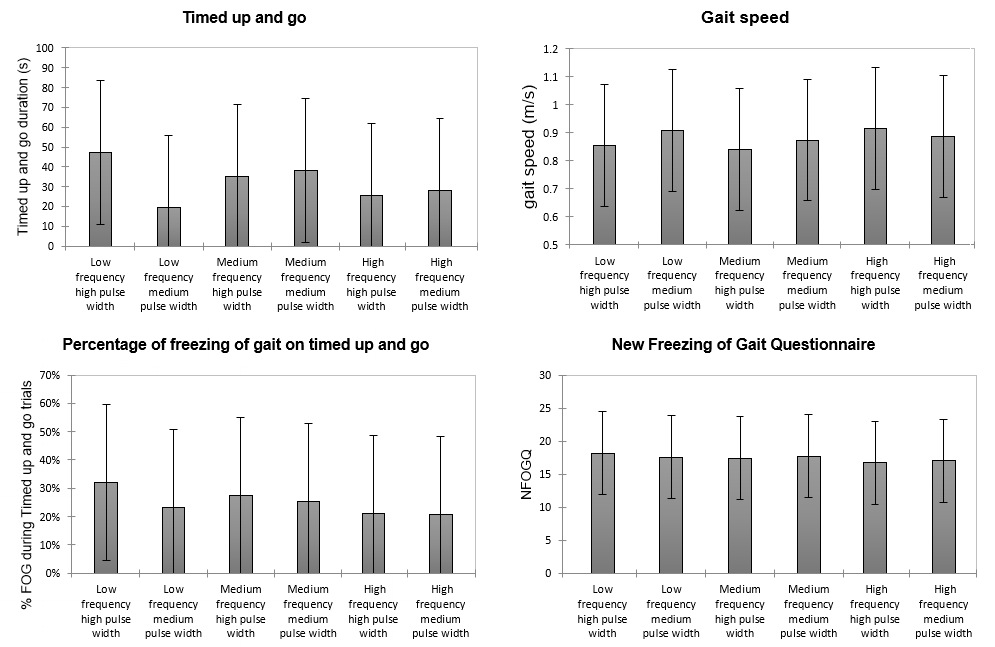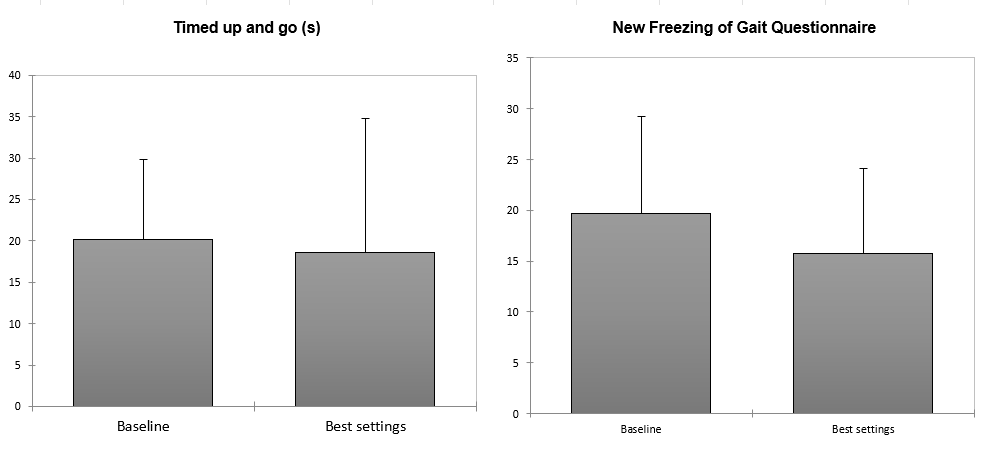Category: Surgical Therapy: Parkinson's Disease
Objective: To assess optimal parameters for tonic spinal cord stimulation (SCS) for Parkinson’s Disease (PD) gait disorders in blinded settings.
Background: SCS is a promising therapy for PD in particular for gait disorders and freezing of gait (FOG), but twelve years since the first human trial no consensus has yet been reached on how to adequately deliver the stimulation, with a plethora of frequency and pulse width combinations reported and no clear relation between settings and clinical effect [1]. Considering that evidence for SCS efficacy is limited by a scarcity of controlled and blinded trials, the lack of agreement on optimal parameters contributes to the uncertainty of efficacy.
Method: Patients diagnosed with PD and presenting with refractory gait complaints were recruited for this single blinded (patient) cross over trial. SCS device was implanted with a paddle lead at T2-T4. Settings were randomized between pulse width of 300 and 500 ms and frequency of 60, 300 or 500 Hz, with stimulation current fixed at 90% of paresthesia inducing threshold. Gait was assessed after two weeks in each group through timed up and go (TUG), percentage of TUG duration with FOG, new freezing of gait questionnaire (NFOGQ) and 5m walk.
Results: Seven patients were selected, with a mean age of 69.1, average 10 years with PD, and Hoehn Yahr between 2 and 3. All evaluations were completed. No statistical difference was demonstrated on gait speed, TUG, NFOGQ, or percentage with FOG during TUG (Figure 1) between parameter groups. Collectively at best parameters, patients had a not statistically significant reduction of 7.4% from baseline, and a likewise not significant 4 points reduction in NFOG-Q scores (figure 2). No side effects from stimulation were reported.
Conclusion: No parameter group was found to be superior, and a comparison of best performance from all evaluations to baseline measurements did not produce improvements on gait. While the lack of optimal parameter could stem from a large degree of individual variability, we found no benefit on gait compared to baseline even on best settings. Therefore, these results suggest that SCS at subthreshold settings might not be effective for gait disorders in PD in multiple frequency and pulse width configurations.
A randomized controlled double blinded cross over follow up to this study is underway and will include a suprathreshold settings comparison and assessment of additional outcomes.
References: 1. Cai Y, Reddy RD, Varshney V, Chakravarthy KV. Spinal cord stimulation in Parkinson’s disease: a review of the preclinical and clinical data and future prospects. Bioelectron Med. 2020 Mar 16;6:5. doi: 10.1186/s42234-020-00041-9.
To cite this abstract in AMA style:
R. Carra, J. Menezes, K. Duarte, M. Teixeira, E. Barbosa, R. Cury. Spinal cord stimulation for gait in Parkinsons disease in subthreshold settings [abstract]. Mov Disord. 2023; 38 (suppl 1). https://www.mdsabstracts.org/abstract/spinal-cord-stimulation-for-gait-in-parkinsons-disease-in-subthreshold-settings/. Accessed July 8, 2025.« Back to 2023 International Congress
MDS Abstracts - https://www.mdsabstracts.org/abstract/spinal-cord-stimulation-for-gait-in-parkinsons-disease-in-subthreshold-settings/


